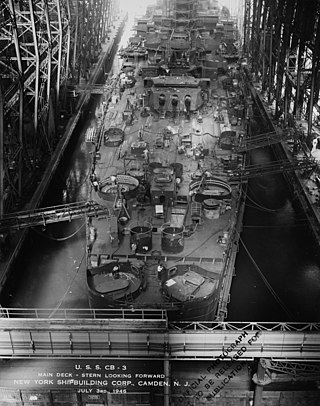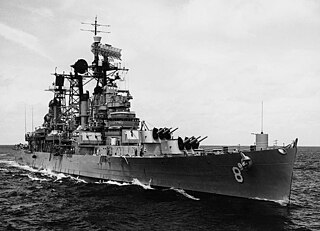
A cruiser is a type of warship. Modern cruisers are generally the largest ships in a fleet after aircraft carriers and amphibious assault ships, and can usually perform several roles.

USS Kentucky (BB-66) was an uncompleted battleship intended to be the last ship of the Iowa class. Hull BB-66 was originally to be the second ship of the Montana-class battleships. However, the urgent need for more warships at the outbreak of World War II and the U.S. Navy's experiences in the Pacific theater led it to conclude that rather than battleships larger and more heavily armed than the Iowa class, it quickly needed more fast battleships of that class to escort the new Essex-class aircraft carriers being built. As a result, hulls BB-65 and BB-66 were reordered and laid down as Iowa-class battleships in 1942.

USS Mississippi (BB-41/AG-128), the second of three members of the New Mexico class of battleship, was the third ship of the United States Navy named in honor of the 20th state. The ship was built at the Newport News Shipbuilding Company of Newport News, Virginia, from her keel laying in April 1915, her launching in January 1917, and her commissioning in December that year. She was armed with a battery of twelve 14-inch (356 mm) guns in four three-gun turrets, and was protected by heavy armor plate, with her main belt armor being 13.5 inches (343 mm) thick.

USS Boston (CA-69/CAG-1), a Baltimore-class heavy cruiser and later a Boston-class guided missile cruiser, was the sixth ship of the United States Navy to be named for the U.S. city of Boston, Massachusetts. Boston was launched 26 August 1942 by Bethlehem Steel Company's Fore River Shipyard in Quincy, Massachusetts, sponsored by Mrs Helen Noonan Tobin, wife of the Mayor of Boston, Maurice J. Tobin, and commissioned 30 June 1943.

USS Hawaii (CB-3) was intended to be the third member of the Alaska-class large cruisers. It was the first United States Navy ship to be named after the then-Territory of Hawaii. Because Hawaii's construction was delayed by higher-priority ships like aircraft carriers, her keel was not laid until December 1943, about two years after her sister ship Guam.

USS Canberra (CA-70/CAG-2) was a Baltimore-class cruiser and later a Boston-class guided missile cruiser of the United States Navy (USN). Originally to be named USS Pittsburgh, the ship was renamed before launch to honor the Australian cruiser HMAS Canberra sunk during the Battle of Savo Island. Canberra was the first USN warship named after a foreign capital city, and one of the few named after a foreign warship not captured in battle with a USN ship.

The Alaska class were six very large cruisers ordered before World War II for the United States Navy, of which only two were completed and saw service late in the war. The US Navy designation for the ships of this class was 'large cruiser' (CB) and the majority of leading reference works consider them as such. However, various other works have alternately described these ships as battlecruisers despite the US Navy having never classified them as such. The Alaskas were all named after territories or insular areas of the United States, signifying their intermediate status between larger battleships and smaller heavy and light cruisers.

The County class was a class of heavy cruisers built for the Royal Navy in the years between the First and Second World Wars. They were the first post-war cruisers constructed for the Royal Navy and were designed within the limits of the Washington Naval Treaty of 1922. Such ships, with a limit of 10,000 tons, standard displacement and 8-inch calibre main guns may be referred to as "treaty cruisers".

The Baltimore-class heavy cruisers were a large class of heavy cruisers in the United States Navy commissioned during and shortly after World War II. Fourteen Baltimores were completed, more than any other class of heavy cruiser, along with three ships of the Oregon City sub-class. The Baltimores also were the first cruisers in the US Navy to be designed without the limitations of the London Naval Treaty.

The Atlanta-class cruisers were eight United States Navy light cruisers which were designed as fast scout cruisers or flotilla leaders but which proved to be effective anti-aircraft cruisers during World War II. They were also known as the Atlanta-Oakland class. The Atlanta class had 12 x 5-inch (127 mm)/38 caliber guns, mounted in three superfiring sets of two-gun turrets fore and three more aft. The first four ships of the class also had an additional two twin 5-inch/38 mounts, one port and one starboard, giving these first four Atlanta-class cruisers the heaviest anti-aircraft armament of any cruiser of World War II. The last four ships of the class, starting with Oakland, had slightly different armament as they were further optimized for anti-aircraft fire.

The Cleveland class was a group of light cruisers built for the U.S. Navy during World War II. They were the most numerous class of light cruisers ever built. Fifty-two were ordered, and 36 completed, 27 as cruisers and 9 as light aircraft carriers. They were deactivated within a few years after the end of the war, but six were converted into missile ships and some of these served into the 1970s. One ship of the class remains as a museum ship.

Originally built as Cleveland-class light cruisers (CL) in the United States Navy during World War II, in 1957 three ships were re-designated as Galveston-class guided missile light cruisers (CLG) and fitted with the Talos long-range surface-to-air missile system. During the two-year refit under project SCB 140, the aft superstructure was completely replaced and all aft guns were removed to make room for the twin-arm Talos launcher and a 46-missile storage magazine. Three large masts were also installed in order to hold a variety of radars, missile guidance, and communications systems. Little Rock and Oklahoma City were simultaneously converted into fleet flagships under SCB 140A, which involved removing two forward dual 5-inch (127 mm) and one triple 6-inch (152 mm) turrets, and replacing them with a massively rebuilt and expanded forward superstructure. Galveston, in the non-flagship configuration, retained the Cleveland-class's standard forward weapons: three dual 5-inch (127 mm) and two triple 6-inch (152 mm) turrets.

Originally built as Cleveland-class light cruisers (CL) in the United States Navy during World War II, in 1957 three ships were re-designated as Providence-class guided missile light cruisers (CLG) and fitted with the Terrier surface-to-air missile system. During the two year refit under project SCB 146, the aft superstructure was completely replaced and all aft guns were removed to make room for the twin-arm Terrier launcher and a 120 missile storage magazine. Three large masts were also installed in order to hold a variety of radars, missile guidance, and communications systems. Providence and Springfield were simultaneously converted into fleet flagships under SCB 146A, which involved removing two forward dual 5-inch (127 mm) and one triple 6-inch (152 mm) turrets, and replacing them with a massively rebuilt and expanded forward superstructure. Topeka, in the non-flagship configuration, retained the Cleveland-class's standard forward weapons: three dual 5-inch (127 mm) and two triple 6-inch (152 mm) turrets.

Leahy-class cruisers were a class of guided-missile cruisers built for the United States Navy. They were originally designated as Destroyer Leaders (DLG), but in the 1975 cruiser realignment they were reclassified as guided-missile cruisers (CG).

The Albany-class guided-missile cruisers were converted Baltimore and Oregon City-class heavy cruisers of the United States Navy. All original superstructure and weapons were removed and replaced under project SCB 172. The converted ships had new very high superstructures and relied heavily on aluminum to save weight.

The aircraft cruiser is a warship that combines the features of the aircraft carrier and a surface warship such as a cruiser or battleship.

The 5"/25 caliber gun entered service as the standard heavy anti-aircraft (AA) gun for United States Washington Naval Treaty cruisers commissioned in the 1920s and 1930s. The goal of the 5"/25 design was to produce a heavy AA gun that was light enough to be rapidly trained manually. The gun was also mounted on pre-World War II battleships and aircraft carriers until replaced by the standard widespread dual-purpose 5"/38 caliber gun, which was derived from the 5"/25. Guns removed from battleships were probably converted for submarine use by late 1943, while a purpose-built variant for submarines was available in mid-1944, and was widely used by them. United States naval gun terminology indicates the gun fired a projectile 5 inches (127 mm) in diameter, and the barrel was 25 calibers long. It is referred to sometimes as a dual purpose gun and sometimes as an anti-aircraft gun, because of its comparative weakness against surface targets.

USS Alaska was the lead ship of the Alaska class of large cruisers which served with the United States Navy during the end of World War II. She was the first of two ships of her class to be completed, followed only by Guam; four other ships were ordered but were not completed before the end of the war. Alaska was the third vessel of the US Navy to be named after what was then the territory of Alaska, and was assigned the hull number CB-1. She was laid down on 17 December 1941, ten days after the United States entered the war, was launched in August 1943 by the New York Shipbuilding Corporation, in Camden, New Jersey, and was commissioned in June 1944. She was armed with a main battery of nine 12 in (300 mm) guns in three triple turrets and had a top speed of 33 kn.

The EOC 10 inch 40 caliber guns were a family of related guns designed by the Elswick Ordnance Company and produced by Armstrong Whitworth in the 1890s for export customers. EOC 10 inch 40 caliber guns were the primary armament of armored cruisers, ironclads and pre-dreadnought battleships built or refit during the 1890s. These guns and their licensed derivatives armed ships of the Argentine Navy, Imperial Japanese Navy, Regia Marina and Spanish Navy. They served in the Russo-Japanese War, Italo-Turkish War and World War I.
The Neptune class was a proposed class of cruisers planned for the British Royal Navy in the latter years of the Second World War. They were large ships which were to be armed with twelve 6-inch (152 mm) dual-purpose guns and with a heavy secondary armament. Although five ships of the class were planned in 1944, they were cancelled following the end of the war, before construction could begin.



















